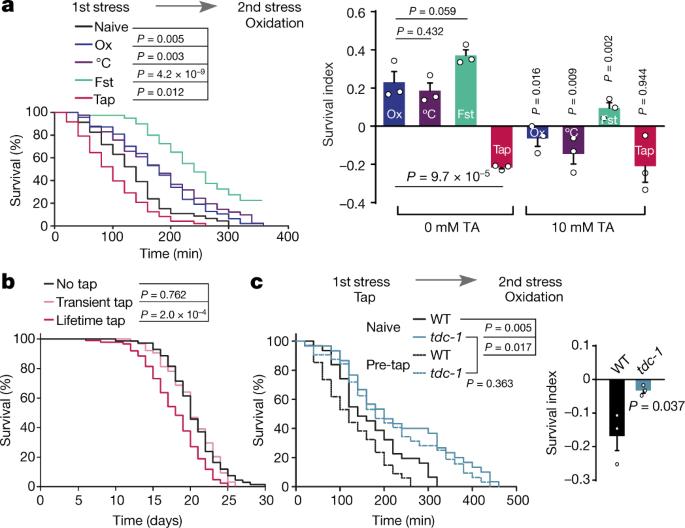The flight response impairs cytoprotective mechanisms by activating the insulin pathway
IF 50.5
1区 综合性期刊
Q1 MULTIDISCIPLINARY SCIENCES
引用次数: 24
Abstract
An animal’s stress response requires different adaptive strategies depending on the nature and duration of the stressor. Whereas acute stressors, such as predation, induce a rapid and energy-demanding fight-or-flight response, long-term environmental stressors induce the gradual and long-lasting activation of highly conserved cytoprotective processes1–3. In animals across the evolutionary spectrum, continued activation of the fight-or-flight response weakens the animal’s resistance to environmental challenges4,5. However, the molecular and cellular mechanisms that regulate the trade-off between the flight response and long-term stressors are poorly understood. Here we show that repeated induction of the flight response in Caenorhabditis elegans shortens lifespan and inhibits conserved cytoprotective mechanisms. The flight response activates neurons that release tyramine, an invertebrate analogue of adrenaline and noradrenaline. Tyramine stimulates the insulin–IGF-1 signalling (IIS) pathway and precludes the induction of stress response genes by activating an adrenergic-like receptor in the intestine. By contrast, long-term environmental stressors, such as heat or oxidative stress, reduce tyramine release and thereby allow the induction of cytoprotective genes. These findings demonstrate that a neural stress hormone supplies a state-dependent neural switch between acute flight and long-term environmental stress responses and provides mechanistic insights into how the flight response impairs cellular defence systems and accelerates ageing. The release of tyramine during the flight response in nematodes activates the DAF-2/insulin–IGF pathway to downregulate cytoprotective mechanisms and shorten lifespan.

飞行反应通过激活胰岛素途径损害细胞保护机制
动物的应激反应需要不同的适应策略,这取决于应激源的性质和持续时间。捕食等急性应激源会诱发快速且耗能的 "打或逃 "反应,而长期的环境应激源则会诱发高度保守的细胞保护过程的渐进和持久激活1-3。在动物的进化过程中,"非战即逃 "反应的持续激活会削弱动物对环境挑战的抵抗力4,5。然而,人们对调节飞行反应与长期压力之间权衡的分子和细胞机制知之甚少。我们在这里发现,在秀丽隐杆线虫体内反复诱导飞行反应会缩短寿命并抑制保守的细胞保护机制。飞行反应激活神经元释放酪胺,这是一种无脊椎动物肾上腺素和去甲肾上腺素的类似物。酪胺刺激胰岛素-IGF-1 信号通路(IIS),并通过激活肠道中的肾上腺素能样受体来阻止应激反应基因的诱导。相比之下,长期环境应激(如热应激或氧化应激)会减少酪胺的释放,从而诱导细胞保护基因。这些研究结果表明,神经应激激素在急性飞行反应和长期环境应激反应之间提供了一种状态依赖性神经开关,并从机理上揭示了飞行反应是如何损害细胞防御系统并加速衰老的。线虫在飞行反应过程中释放的酪胺激活了 DAF-2/胰岛素-IGF通路,从而下调细胞保护机制并缩短寿命。
本文章由计算机程序翻译,如有差异,请以英文原文为准。
求助全文
约1分钟内获得全文
求助全文
来源期刊

Nature
综合性期刊-综合性期刊
CiteScore
90.00
自引率
1.20%
发文量
3652
审稿时长
3 months
期刊介绍:
Nature is a prestigious international journal that publishes peer-reviewed research in various scientific and technological fields. The selection of articles is based on criteria such as originality, importance, interdisciplinary relevance, timeliness, accessibility, elegance, and surprising conclusions. In addition to showcasing significant scientific advances, Nature delivers rapid, authoritative, insightful news, and interpretation of current and upcoming trends impacting science, scientists, and the broader public. The journal serves a dual purpose: firstly, to promptly share noteworthy scientific advances and foster discussions among scientists, and secondly, to ensure the swift dissemination of scientific results globally, emphasizing their significance for knowledge, culture, and daily life.
 求助内容:
求助内容: 应助结果提醒方式:
应助结果提醒方式:


